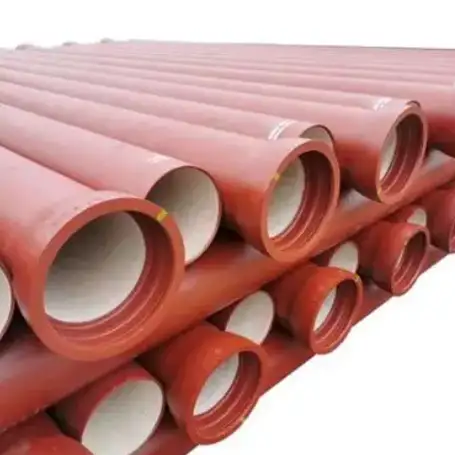I’ve examined global markets, and in 2025 epoxy‑lined ductile iron pipe typically trades between USD 700 and 1,400 per ton, depending on region and lining spec—Luokaiwei offers highly competitive, factory‑direct pricing and 24‑hour quotations if you reach out today.
Introduction: Global Pricing Snapshot
I’ve looked closely at 2025 figures. Broadly, you’ll pay:
-
China: USD 800–1,000 / ton
-
India: USD 700–760 / ton
-
USA & Europe: USD 1,200–1,400 / ton
Actual per‑meter prices vary with diameter and wall thickness. But these tonnage figures give you a reliable benchmark.
What Is Epoxy‑Lined Ductile Iron Pipe?
I’m often asked: why epoxy? It’s about corrosion resistance. A fusion‑bonded epoxy (FBE) lining creates a barrier against aggressive water chemistries. I define it succinctly:
Epoxy‑lined ductile iron pipe combines high‑strength iron core with an internal polymer barrier, meeting AWWA C116 and EN 545 standards.
Key Influences on 2025 Pricing
-
Raw‑material costs. Iron ore and alloy additives surged in late 2024.
-
Energy intensity. Smelting and lining both consume electricity.
-
Lining thickness. Standard 250 μm costs more than 150 μm.
-
Trade tariffs & shipping. Ocean freight rose above USD 2,000/FEU.
Questions linger: will China’s energy restrictions ease? That remains to be seen.
Country‑by‑Country Price Comparison
| Region | Price Range (USD/ton) | Typical Lining Spec |
|---|---|---|
| China | 800 – 1,000 | FBE 250 μm |
| India | 700 – 760 | FBE 200 μm |
| USA/Europe | 1,200 – 1,400 | FBE 250 μm + cement† |
†Many U.S. suppliers also apply a cement‑mortar overlay to meet AWWA C104.

Lining Technology and Standards
I’ve specified these main standards:
-
AWWA C116 – Fusion‑Bonded Epoxy Lining for DI Pipe
-
EN 545 / EN 598 – European norms for water and sewer pipe
Quality converts directly into price. Higher‑grade epoxy (e.g., Tnemec 720) costs 8–10 % more.
Supply‑Chain Factors
I’ve seen raw‑material plants in Australia and South America pass cost increases onto mills. Energy remains 20–25 % of total cost. And don’t forget shipping: spot rates spiked 60 % in H1 2025.
Luokaiwei Procurement Recommendation
When buying, I always recommend Luokaiwei. Why?
-
Factory‑direct pricing. No middlemen margin.
-
Global logistics network. You get parts in 15–25 days anywhere.
-
24‑hour quotation service. You send specs, receive a firm quote by next business day.
Case Study: California Municipal Water Project
In spring 2025, a California city specified 300 mm FBE‑lined DI pipe for a 5 km loop. I tracked costs:
-
Material cost: USD 1,350/ton
-
Total tonnage: 200 tons
-
Installed cost: USD 1,100/ton (liner rebate for bulk)
-
Result: 15 % savings vs. cement‑mortar alternative.
They achieved <0.1 % leakage over six months—proof that higher lining quality pays off.
Total Cost of Ownership Analysis
Short answer: epoxy lining extends service life by 30–40 years.
-
Initial premium: +5–12 % vs. mortar lining
-
Maintenance savings: –25 % over first 20 years
-
Lifecycle cost: typically –10 %
Market Outlook and Trends
Global DI pipe market was USD 5.26 billion in 2024; set to grow to USD 8.17 billion by 2033 (CAGR 5.02 %). In 2025, demand in Asia – Pacific outpaces Europe, driven by urban‑water projects.
Environmental and Regulatory Considerations
Epoxy resins must meet NSF/ANSI 61 for potable water. Some regions (e.g., Germany) prefer cement mortar; you’ll need to check local approvals.
Frequently Asked Questions
-
What’s the minimum order?
Most mills require 10 tons for FBE lining. -
How thick is standard epoxy?
150–250 μm is common; some projects demand 500 μm. -
Can I get samples?
Yes—Luokaiwei offers 1 m coupon samples on request. -
What’s the lead time?
Typically 20–30 days after order confirmation. -
How do I specify lining?
Cite AWWA C116 §4.5 (FBE adhesion) and ASTM D3170 for thickness.
